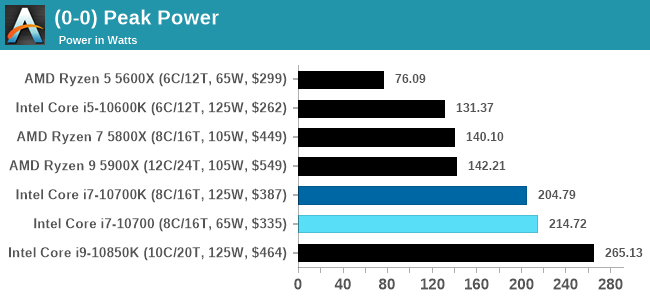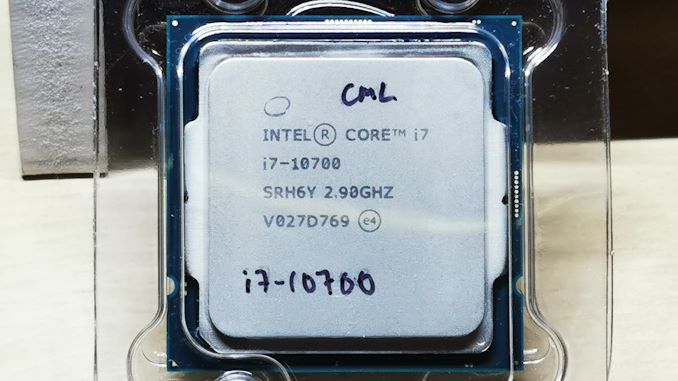Intel Core i7-10700 vs Core i7-10700K Review: Is 65W Comet Lake an Option?
by Dr. Ian Cutress on January 21, 2021 10:30 AM EST- Posted in
- CPUs
- Intel
- Core i7
- Z490
- 10th Gen Core
- Comet Lake
- i7-10700K
- i7-10700
Conclusion: TDP is Not Fit For Purpose
In years gone by, processors were sold with a single frequency and power rating. It was very quickly realized that if a processor could effectively go to sleep, using either lower voltage or lower frequency (or both) then a lot of idle power could be saved. Going the other way, processor designers realized that for temporary short bursts, a core could run at a higher frequency before it reached a thermal limit. Also, using a multi-core processor meant that either the power budget could be shared across all the cores, or it could be focused in one.
Both AMD and Intel have noticed this over time, and both companies have different attitudes on how they report numbers relating to ‘base frequency’ and related power as well as the bursty ‘turbo frequency’ and related power. Out of those four metrics, the only one Intel doesn’t provide is turbo power, because from their perspective it is system dependent.

Intel lets motherboard manufacturers determine how long a system can turbo for, and what that budget is. Intel encourages motherboard manufacturers to over-engineer the motherboards, not only for overclocking, but for non-overclockable CPUs to get the best performance for longer. This really messes up what the ‘default out-of-the-box performance’ should be if different motherboards give different values. The trend lately is that enthusiast motherboards enable an unlimited turbo budget, and the user building their system just has to deal with it.
This means that users who buy the Core i7-10700 in this review, despite the 65 W rating on the box, will have to cater for a system that will not only peak around 215 W, but sustain that 215 W during any extended high-performance load, such as rendering or compute. We really wished Intel put this 215 W value on the box to help end-users determine their cooling, as without sufficient guidance, users could be hitting thermal limits without even knowing why. At this point, 'Intel Recommended Values' for turbo time and budget mean nothing outside of Intel's own OEM partners building commercial systems.
Core i7-10700 vs Core i7-10700K Performance
In the review we highlighted that these two processors have a peak turbo frequency difference of 300 MHz and an all-core turbo frequency difference of 100 MHz. The fact that one is rated at 65 W and the other is rated at 125 W is inconsequential here, given that most end-user motherboards will simply enable turbo all the time. This means the performance in most of our tests between the two is practically identical, and consummate to a 100-300 MHz frequency difference.
In practically all of our tests, the Core i7-10700K is ahead by a super slim margin. At $387 for the 10700K compared to $335 for the 10700, the performance difference is not enough to warrant the $52 price difference between the two. Performance per dollar sides mostly with the Core i7-10700, although users getting the i7-10700K will likely look towards overclocking their processor to get the most out of it – that ultimately is what to pay for.
The other comparison point is with the Ryzen 5 5600X, which has two fewer cores but costs $299. In practically every test, the increased IPC of the Ryzen over Intel means that it sits identical with the Core i7 processors, AMD is cheaper on list price, and at a much lower power (AMD will peak around 76 W, compared to 215 W). AM4 motherboards are also abundant, while corresponding Intel motherboards are still expensive. The problem here however is that AMD is having such high demand for its product lines right now that finding one in stock might be difficult, and it probably won’t be at its recommended price.
Users in this price bracket have a tough choice – the more efficient AMD processor that might be in stock, compared to the Intel processor that will be in stock but more cooling will likely be required.











210 Comments
View All Comments
schujj07 - Friday, January 22, 2021 - link
A stock 3700X has a total package power of 88W and the 212 EVO is a 150W TDP cooler. Whereas the included Wraith Prism cooler with the 3700X is a 125W TDP cooler. One would expect that the larger capacity cooler with the larger fan would be quieter.vegemeister - Friday, January 22, 2021 - link
Heat transfer does not work that way.ΔT = P * R
where T is temperature (K), P is power (W), and R is thermal resistance (K/W).
Unless the temperature rise is known the only thing "150W cooler" tells you is that the heat pipes won't dry out at 150W with reasonable ambient temperature. (That's a thing that can happen. It's not permanent damage, but it does mean R gets a lot bigger.)
The fact is the Wraith Prism is the same 92mm downdraft cooler AMD has been shipping with their CPUs since the Phenom II 965.
Spunjji - Friday, January 22, 2021 - link
The Wraith Prisms are fine - the one that comes with the low-end ryzens (and I think now the 5600) aren't so great for noise, but they do let the CPU come within 95% of its peak performance, so not bad for a freebie.alufan - Thursday, January 21, 2021 - link
Am not seeing the point of this article is 65w an option and then you blatantly ignore the actual TDP stated and produce a test, for the test to be a fair comparison all the chips should be limited to actual power stated and then run through any Benchmarks, its like saying we are testing CPUs at 125w and including the LN2 FX AMD chip and seeing how much power you can actually run through it, running these chips like this constantly will degrade them and eat up a considerable amount of power that you dont need to use.Then again I should be surprised, yet again 12 articles on the front page regarding Intel 3 regarding AMD guess Intels media budget is bigger hmm
DominionSeraph - Thursday, January 21, 2021 - link
It's AMD CPUs that degrade at stock clocks. Intel will run for decades even with moderate overclocks.bji - Thursday, January 21, 2021 - link
AMD CPUs do not "degrade" at stock clocks or overclocks.DominionSeraph - Thursday, January 21, 2021 - link
Their Turbo is literally built around it. It will lower clocks as the chip degrades. The degradation is all over Reddit. I'm surprised no tech site has followed up on the scandal.bigboxes - Thursday, January 21, 2021 - link
I'm surprised there aren't more trolling like youSpunjji - Friday, January 22, 2021 - link
I'm not.I just spent a bit of time on Google and the majority of the results are people saying "I heard this, is it true?" - the rest are people talking about how they ran their chip way outside spec (significant overvoltage, overclock *and* high temperatures) and can no longer get the same overclock out of it.
Take your FUD and cram it. 🥰
Spunjji - Friday, January 22, 2021 - link
It took me less than 15 minutes to confirm that this is a lie.Incidentally, the only CPUs I've ever had "degradation" problems with were all Sandy Bridge - 2 i3s, one i5 and one i7. Only one of them was ever overclocked. They started to show strange issues after 3-5 years - stuff like frame-rate inconsistency in games, graphics artefacts, random crashes.
I've never gone around slamming Intel, though, because sometimes you just get a bad chip. It happens.